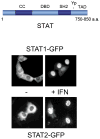STAT dynamics
- PMID: 17683973
- PMCID: PMC2683581
- DOI: 10.1016/j.cytogfr.2007.06.021
STAT dynamics
Abstract
The ability of transcription factors to gain entrance to the nucleus is critical to their role in gene expression. Signal transducers and activators of transcription (STATs) are latent DNA binding factors activated by specific tyrosine phosphorylation. There are seven mammalian STAT genes encoding proteins that display constitutive nuclear localization and/or conditional nuclear localization. This review will focus on STAT1 and STAT2 that are activated in response to interferon and exhibit conditional nuclear localization. The dynamic redistribution of STAT1 and STAT2 between the cytoplasm and the nucleus is coordinate with their gain of ability to bind DNA.
Figures





Similar articles
-
Inhibition of interferon signaling by rabies virus phosphoprotein P: activation-dependent binding of STAT1 and STAT2.J Virol. 2006 Mar;80(6):2675-83. doi: 10.1128/JVI.80.6.2675-2683.2006. J Virol. 2006. PMID: 16501077 Free PMC article.
-
A family-wide assessment of latent STAT transcription factor interactions reveals divergent dimer repertoires.J Biol Chem. 2023 May;299(5):104703. doi: 10.1016/j.jbc.2023.104703. Epub 2023 Apr 12. J Biol Chem. 2023. PMID: 37059181 Free PMC article.
-
STAT2 nuclear trafficking.J Biol Chem. 2004 Sep 17;279(38):39199-206. doi: 10.1074/jbc.M400815200. Epub 2004 Jun 1. J Biol Chem. 2004. PMID: 15175343
-
STATs get their move on.JAKSTAT. 2013 Oct 1;2(4):e27080. doi: 10.4161/jkst.27080. Epub 2013 Nov 13. JAKSTAT. 2013. PMID: 24470978 Free PMC article. Review.
-
A Positive Feedback Amplifier Circuit That Regulates Interferon (IFN)-Stimulated Gene Expression and Controls Type I and Type II IFN Responses.Front Immunol. 2018 May 28;9:1135. doi: 10.3389/fimmu.2018.01135. eCollection 2018. Front Immunol. 2018. PMID: 29892288 Free PMC article. Review.
Cited by
-
A review of JAK-STAT signalling in the pathogenesis of spondyloarthritis and the role of JAK inhibition.Rheumatology (Oxford). 2022 May 5;61(5):1783-1794. doi: 10.1093/rheumatology/keab740. Rheumatology (Oxford). 2022. PMID: 34668515 Free PMC article. Review.
-
Activation of human monocytes by live Borrelia burgdorferi generates TLR2-dependent and -independent responses which include induction of IFN-beta.PLoS Pathog. 2009 May;5(5):e1000444. doi: 10.1371/journal.ppat.1000444. Epub 2009 May 22. PLoS Pathog. 2009. PMID: 19461888 Free PMC article.
-
Recessive, gain-of-function toxicity in an APOL1 BAC transgenic mouse model mirrors human APOL1 kidney disease.Dis Model Mech. 2021 Aug 1;14(8):dmm048952. doi: 10.1242/dmm.048952. Epub 2021 Aug 5. Dis Model Mech. 2021. PMID: 34350953 Free PMC article.
-
Interleukin (IL)-1 and IL-6 regulation of neural progenitor cell proliferation with hippocampal injury: differential regulatory pathways in the subgranular zone (SGZ) of the adolescent and mature mouse brain.Brain Behav Immun. 2011 Jul;25(5):850-62. doi: 10.1016/j.bbi.2010.09.003. Epub 2010 Sep 15. Brain Behav Immun. 2011. PMID: 20833246 Free PMC article.
-
A haplotype at STAT2 Introgressed from neanderthals and serves as a candidate of positive selection in Papua New Guinea.Am J Hum Genet. 2012 Aug 10;91(2):265-74. doi: 10.1016/j.ajhg.2012.06.015. Am J Hum Genet. 2012. PMID: 22883142 Free PMC article.
References
-
- Fu XY. A transcription factor with SH2 and SH3 domains is directly activated by an interferon alpha-induced cytoplasmic protein tyrosine kinase(s) Cell. 1992 Jul 24;70(2):323–35. - PubMed
-
- Schindler C, Shuai K, Prezioso VR, Darnell JE., Jr Interferon-dependent tyrosine phosphorylation of a latent cytoplasmic transcription factor [see comments] Science. 1992;257(5071):809–13. - PubMed
-
- Barbieri G, Velazquez L, Scrobogna M, Fellous M, Pellegrini S. Activation of the protein tyrosine kinase tyk2 by interferon alpha/beta. Eur J Biochem. 1994 Jul 15;223(2):427–35. - PubMed
Publication types
MeSH terms
Substances
Grants and funding
LinkOut - more resources
Full Text Sources
Other Literature Sources
Research Materials
Miscellaneous

